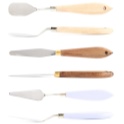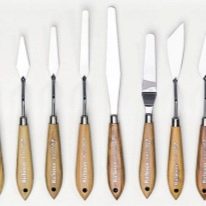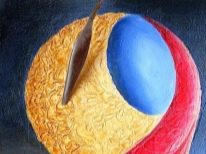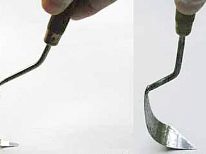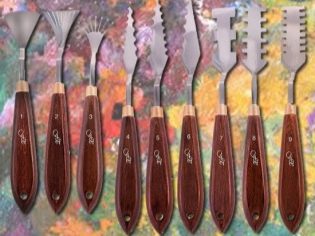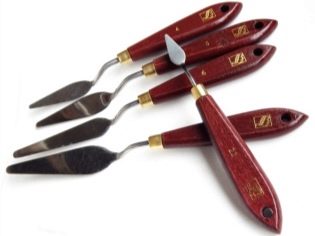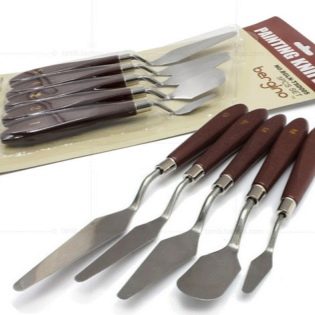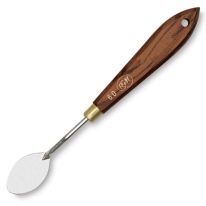Types of mastichins: how to choose?
To master all possible techniques of painting and drawing it is necessary not only to study diligently, but also to use all kinds of tools that allow you to apply paint on a canvas in different ways. Perhaps, any professional artist must at least once in his life try to work with such a tool as a palette knife. However, many newbies have only a superficial idea of what it is, how to choose it and how to use it.
Special features
The name "palette knife" comes from the Italian word, which can be translated as "spatula", because such an artistic tool really looks like a small spatula or even a knife. As a rule, professionals actively use this tool when working with oil or acrylic paints, although recently there has been a slight increase in interest in the palette knife among watercolorists.
The appointment of such a spatula is quite multifaceted: He will help to mix paint on the palette, and then clean it of pigment, remove an excess amount of paint from the canvas or paint a picture without a brush.
It should be noted that the latest technique is becoming more popular, since the result is quite different from classical painting. Of course, the form of the design does not imply the prescribing of subtle details, however, due to the lack of inevitable blurring of colors when using the brush, the palette knife gives an amazingly bright and saturated color. A characteristic feature of the paintings, written by a palette knife, is also an expressive texture, which traditionally two-dimensional painting slightly turns into a three-dimensional picture.
Of course, professionals do not paint a serious picture with a single technique and a palette knife is used in combination with classical brush strokes. The art spatula is used for large forms of the front or middle plan with an underlined, pronounced texture. These include architectural objects, excitement on the water, stony landscapes and other relevant topics.
It is possible that the palette knives were widely used by artists in the Renaissance, but then they were more perceived as an auxiliary tool for working with the palette, and not as a substitute for the brush. The modern understanding of the role of the spatula in painting has spread only in the last century, when literally everything began to be painted with it, but earlier some famous artists gradually used it to paint on a canvas. Among the outstanding masters at least occasionally using such a technique, it is worth mentioning Titian, Francisco Goya, Gustave Courbet and Paul Cezanne.
The artists themselves note that learning to draw with a spatula is not so difficult, and it can be used both in combination with a brush and independently of it.
For those who for a long time have become accustomed to working exclusively with a brush, at first it may seem inconvenient at first, but the possibilities it reveals are worth trying.
Types of art spatulas
Like most modern products, palette knives are divided into several types for one or another quality. A professional artist, in the first place, is concerned with the classification according to the method of application, since it plays a huge role in choosing a tool.
Originally, blades of this type were designed to work with the palette, and these days, of course, they have not gone away.Palette knife for the palette is a flat tool, which has no bend near the handle. The edge of such a spatula is necessarily pointed, because with its help the master removes the dried paint from the palette. This form is also convenient for mixing paints on the surface of the palette, and for removing excess oil from the canvas.
Palette knife directly for drawing are particularly curved, which increases the accuracy of the work with the canvas. The blade of such a tool is usually different elasticity, which contributes to a softer application of paint on the substrate. The variety of spatulas of the artistic direction itself is quite large: first of all, they differ in size, which makes it easier to adjust to the different sizes of the canvas.
The width of the blade also varies: a narrow tip is more flexible and more inherent to the brush, while wider tools are better suited for imparting relief to larger objects. In this case, the exact shape of the scapula can represent the most unexpected shapes to achieve the complex goals facing the master.
Variability of palette knives is also possible on the basis of the material. Handles are made of any convenient materials, among which usual wood and plastic, and also more exotic - a bone and glass.
Only two materials are suitable for the blade: the expected metal and some unexpected plastic. Metal spatula blades are considered the norm and the classics: they bend well, but sometimes they can disappoint with their quality, because individual alloys contribute to the oxidation of oil paints. Among the metallic palette knives, those made of stainless steel are particularly successful, since moisture is not terrible for them.
Plastic varieties of artistic trowel are good except at their price, because they quickly break down and are suitable in the long run, in fact, only for mixing paints. You only need to choose them in order to try yourself in such a painting technique.
Criterias of choice
Artists with sufficient experience in drawing and having the opportunity to ask advice from familiar colleagues often decide on the choice of palette knife on their own, but the beginner will definitely need advice on how to choose the right spatula. For a kind of "trial of the pen," it is better to buy a plastic version, since it is cheaper, and the recruit himself cannot yet be sure that he will like this technique.
The choice of the shape of the blade can also bother a novice, because for artistic purposes they are produced in a wide variety of variations.
Professionals say that it is best to try on a drop-shaped and geometrically correct blade (not on just one, but on both) and only then choose more unusual options.
The shape of the blade largely determines not only the aesthetic effect of the design, but also the convenience of using a spatula. For example:
- to save the canvas from mechanical damage, it is worth choosing rounded blades;
- remove excess paint, which in itself is a separate technique, allows a pointed blade;
- the texture is best transmitted if a palette knife with an oval blade was used to create it;
- if there is a need to write out clear lines, one cannot do without a geometrically regular blade;
- Palette knives with a particularly complex blade shape are needed only by professionals who have already mastered the principles of working with simpler variants.
At the same time, when choosing a tool, one should focus not only on the predicted creative effect, but also on the banal convenience of the handle and the quality of the goods. Although the product looks simple, there are several criteria that distinguish quality from mediocre:
- The blade of a palette knife will never be as elastic as the pile of the brush, but a springy tip is considered a sign of a good artistic tool.
- The spatula consists of only two parts - the handle and the blade, and for the artist it is very important that they are interconnected as securely as possible. The slightest chattering, or worse, scrolling can ruin a real masterpiece, and it’s hard to fix an oil painting, as you know.
- The artist's tool should be an extension of his hand - he should lie comfortably in the palm of his hand. The presence of any defects in the handle is unacceptable, and blots of wood processing in the form of potential splinters - this is a real shame for the manufacturer of such goods.
Range
It is usually possible to purchase an artistic palette knife where other related products are sold, such as oil paints, brushes and canvases for them. Even a novice artist can afford such a gift, because the average spatula costs only about 100-250 rubles.
Another thing, if you buy several mastikhs at once, because here, as in the case of brushes, a set of tools of various shapes and sizes contributes to an increased variety of creative methods.
A set of inexpensive plastic spatulas that will help a novice in this technique to fully grasp the main advantages of this method of creation will cost the same 200 rubles, but a set of good tools with metal tips will hit the wallet more, and even the price of a thousand rubles will not be the upper limit.
If we talk about manufacturers of knives, the choice of brands is not as great as in the case of paints or brushes, and there is no generally recognized authority here, respectively. A person who has never understood this topic will be able to say something brand "Sonnet"Since the very high-quality domestic paints of the Leningrad factory of artistic paints have been produced under the same brand for several decades.
Spatulas can make a worthy competition for this company. Art Quarter, Conda, RGM Classic, PinaxArtists Classic and Daler RowneyHowever, it is difficult to make a reasoned choice in favor of one of these brands - they are all approximately the same in quality and cost.
Choose or make yourself?
Many men who are capable of creating masterpieces with their hands, not only with a brush and paints, but also with the help of typical male tools, refuse to spend money and time searching and buying the necessary palette knife, if it is possible to make it with their own hands. As the experience of such people shows, the result turns out to be quite worthy: it hits the wallet much less, and most importantly, it best matches the wishes of its owner.
The most difficult thing in the process of self-production of a spatula is to create a blade of the required shape. First you need to find a piece of metal (hardly anyone would lose time on the home issue of the plastic version), from which you can make a blade. From the options of potential raw materials offered on the Internet, old construction spatulas, old hacksaws and even a metal folding meter made in Russia look realistic. Depending on the shape and size of the raw sheet from it using the "Bulgarian", a special hacksaw or scissors for metal cut blanks for future blades.
The imparting of an exact shape becomes possible due to sharpening and grinding the edges, as a result of which the degree of sharpness of the blade is also determined.
The part that provides the connection between the blade and the handle can be made in different ways. If the sheet of metal used was rather large, it is better to make it solid, combined with the core of the future handle in the process of cutting the blade. In this case, the metal billet will need to be bent, for which it is white-hot.
A similar procedure can be performed even at home, if the metal is heated for a long time over an ordinary gas burner, but then you need to observe safety precautions as closely as possible.. It is possible to fasten the individual parts from which the homemade trowel is made, using a large nail, for example, slate. It must be bent at the desired angle and inserted into both parts of the palette knife through specially made holes.
The handle for a homemade trowel can be made independently, turning it out of wood on the machine, but buying a finished product, which will cost the consumer several dozen rubles, will also be very practical. As a rule, in the factory blank there is already a hole for the insertion of the metal part, which you just need to flatten correctly on the back side of the blade in order to avoid razbaltyvaniya structures.
After that, it is worth once again to tap the joints with a hammer in order to properly flatten the joints and to ensure the immobility of fastening some parts to others. The exact cost of the manually made palette knife varies greatly depending on the availability of available tools from which it can be made. However, users who have experience of such handicrafts, indicate the cost of producing one such tool within a hundred rubles.
How to choose a palette knife, see the next video.






